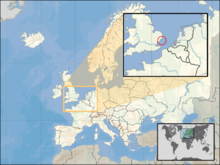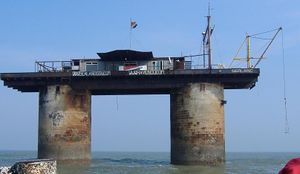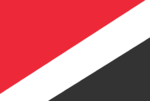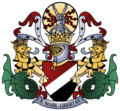Principado de Sealand
| |||
| Lema E Mare Libertas (Español: Desde el Mar, Libertad) | |||
 Mar del Norte A 13 Kilometros de la costa de Suffolk. | |||
| Capital | HM Fort Roughs | ||
|---|---|---|---|
| Lenguaje Oficial | Inglés | ||
| Gentilicio | Silandés, Silándico | ||
| Gobierno | Monarquía Constitucional | ||
| - Príncipe | Michael I | ||
| Formación | 2 de septiembre 1967 | ||
| Territorio Reclamado | HM Fort Roughs | ||
| Habitantes | 28 (estimación 2011) | ||
| Moneda | Dólar de Sealand | ||
| Formato de Fecha | dd-mm-yyyy | ||
| Official website | |||
El Principado de Sealand es una micronación que reclama como su territorio la plataforma artificial de Roughs Tower, una ex plataforma marina Maunsell ubicada en el Mar del Norte a 10 km (seis millas) desde la costa de Suffolk, Inglaterra; y, a su vez, en aguas internacionales a 12 millas nauticas del territorio inglés. Sealand es ocupada por familiares y amigos de Paddy Roy Bates, quien se autoproclamó como Su Alteza Real Príncipe Roy de Sealand. El Príncipe Roy falleció el año 2012 y el principado es actualmente dirigido por su hijo el Príncipe Michael I. La población dentro de la facilidad marítima raramente excede de 5 personas y su área habitable es de 550m².
Aunque los reclamos de soberanía y legitimidad de Sealand no son reconocidos por ningún país miembro de la ONU, es probablemente la micronación más conocida a nivel mundial, es incluso citada ocasionalmente en debates como un interesante caso de estudio en como varios principios del Derecho internacional pueden ser aplicados en una disputa territorial. Existen numerosas compañias corporativas que actualmente se adjudican ser representantes legítimos de Sealand, la más grande siendo controlada por un grupo de empresario alemanes quienes son un pseudo gobierno en exilio del Principado, y que usan este título para generar documentos de ciudadanía fraudulentos, loterias, bancos e inlcuso apuestas online. El Principado recientemente ha comenzado operaciones en su propio Forum e incluso ha vendido partes de Sealand aunque estas se mantienen bajo la soberanía de Sealand.
Historia
En 1942, durante la Segunda Guerra Mundial, el Reino Unido construyó el HM Fort Roughs como una de sus plataformas marinas Maunsell. was constructed by the UK as one of the Maunsell Sea Forts. Está compuesta por un pontón flotante con una superestructura de dos torres huecas unidas por una plataforma sobre la cual otras estructuras pueden añadirse. El fuerte fue remolcado a una posición sobre el banco de arena Rough Sand sobre su base fue intencionalmente inundada para que se hundiera y reposara sobre el banco de arena. El lugar escogido se encontraba en aguas internacionales, fuera de las que en aquel entonces eran 3 millas de aguas territoriales pertenecientes al Reino Unido.
La plataforma (llamada Roughs Tower) fue ocupada por entre 150 a 300 miembros del personal de la Marina Real Británica durante la Segunda Guerra Mundial; post guerra no fue hasta 1956 que el último miembro del personal a tiempo completo fue retirado del HM Fort Roughs y su posicición fue marcada como un peligro para las embarcaciones por lo que fue puesta en manos de la Trinity House. El 2 de septiembre de 1967 el fuerte fue ocupado por Major Paddy Roy Bates, un británico emisor de una radio pirata quien echó del lugar a un grupo competidor de emisores piratas y reclamó soberanía sobre la base de su interpretación del Derecho Internacional (ver Situación Legal).

En 1968 el hijo de Roy, Michael, fue citado a la corte como resultado de un incidente durante el cual se disparó a un buque de la marina británica. De acuerdo a algunos reportes, los ocupantes del buque pretendian desalojar a la familia Bates de la fortaleza, otro resportes sin embargo sugieren que simplemente estaban intentando reparar una boya de navegación cercana. En la resolución del 25 de noviembre de 1968 la corte, en Chelmsford, Essex, declaró que debido a que el incidente ocurrió fuera de las aguas territoriales británicas la corte no posee jurisdicción alguna. Bates citó dicha sentencia como evidencia de soberanía de facto.
En 1978, mientras Bates no se encontraba en el fuerte, el Primer Ministro de Sealand, Alexander G. Achenbach, y varios ciudadanos alemanes y holandeses orquestaron la toma de la Roughs Tower por la fuerza manteniendo captivo al hijo de Bates, Michael, antes de liberarlo varios días despúes en los Países Bajos.
Bates entonces se surtió de asistencia armada y, en un helicóptero de asalto, retomó la fortaleza. Luego, tomó a sus invasores captivos, declarándolos como prisioneros de guerra. La mayoría de los participantes de la invasión fueron repatriados en el cese de la guerra, pero Gernot Pütz, un abogado alemán que poseía un pasaporte de Sealand, fue condenado por traición hacia Sealand y fue retenido hasta que pagara DM75.000 (más de £18.000 libras esterlinas). Los gobiernos de los Países Bajos y Alemania le pidieron al gobierno británico su libertad, pero el Reino Unido se exculpó de toda responsabilidad citando la decisión de su corte en 1968. Alemania envió entonces a un diplomático desde su embajada en Londres a la Roughs Tower para negociar la libertad de Pütz, luego de varias semanas Roy Bates cede a la petición para luego declarar que dicha visita del diplomático constituía un reconocimiento de facto por parte de Alemania hacia Sealand.
Luego de su repatriación, Achenbach estableció ungobierno en exilio en Alemania, en oposición a Roy Bates, asumiendo el nombre de Presidente del Consejo Privado. Luego de la renuncia de Achenbach por motivos de salud en agosto de 1989, el Ministro de Cooperación Económica del gobierno rebelde, Johannes Seiger, asumió el control bajo el nombre de Primer Ministro y Presidente del Consejo Privado. Seiger continua reclamando que su legítima autoridad como gobernador de Sealand.
Sealand reclama las aguas que rodean la Roughs Tower hasta 12 millas náuticas, [1] y ha físicamente defendido su reclamo territorial en al menos una ocasión: en un incidente de 1990 en el cual el Buque de Auxilio Marítimo Real Golden Eye fue disparado desde Sealand.
Durante algún tiempo los pasaportes de Sealand fueron manufacturados y vendidos ampliamente (mayoritariamente a europeos del este) por un grupo con base en España. Estos pasaportes, que no fueron autorizados por la familia Bates, fueron enlazados a varios crimenes de alto perfil, incluyendo el asesinato de Gianni Versace. Devido ala cantidad masiva de pasaportes ilegales en circulación (un estimado de 150.000), en 1997 la familia Bates revocó todos los pasaportes de Sealand, incluyendo aquellos que ellos mismos habían emitido durante los últimos 30 años.
En 1987 Reino Unido expandió sus aguas territoriales en 9 millas naúticas. Esto abarcó el area del banco de arena Rough Sands. En 1990-1991 Reino Unido publicó como evidencia una sentencia de una corte administrativa de los Estados Unidos de America en la cual se declaraba al efecto que no existe ni ha existido ul independiente llamado Principado de Sealand. Dicha sentencia no fue apelada por la familia Bates quienes declaran que las cortes de Estados Unidos no tienen jurisdicción para determinar la legitimidad de otros Estados.
Situación Legal

El reclamo de Sealand sobre ser un Estado independiente se base en las siguientes proposiciones:
- Cuando Paddy Roy Bates y sus asociados ocuparon la Roughs Tower en 1967 esta se encontraba en aguas internacionales, fuera de la jurisdicción del Reino Unido y de cualquier otro Estado soberano. Sealand reclama de iure legitimidad sobre esta base.
- Las interacciones del gobierno de Reino Unido con Sealand constituyen reconocimiento de facto. Sealand reclama legitimidad de facto sobre esta base.
En el Derecho internacional, las dos escuelas de pensamiento más relevantes sobre la creación de los Estados son la escuela constitutiva y la escuela declaratoria. La teoría constitutiva fue la predominante en el siglo XIX, mientras que la teoría declaratoria fue desarrollada en el siglo XX para responder los vacíos e inexplicaciones derivadas de la teoría constitutiva. La teoría constitutiva establece que un Estado existe exclusivamente a través del reconocimiento por parte de otros Estados. Esta teoría se divide entre si dicho reconocimiento debe ser reconocimiento diplomático o meramente reconocimiento de existencia. Es claro que ningún otro Estado reconoce diplomaticamente a Sealand, pero se ha argumentando por parte de Bates uqe las negociaciones llevadas a cabo por Alemania constituyen reconocimiento de existencia. En la teoría declaratoria de Estaods, una entidad se convierte en Estado cuando esta reune los requisitos mínimos para la formación de un Estado. El reconocimiento por parte de otro Estados es para esta teoría de un carácter meramente declaratorio.
Un conjunto de requisitos para la existencia de un Estado bajo el Derecho internacional es defino por el Tratado de Montevideo. Este establece que un territorio definido, población permanente, gobierno y la capacidad de entablar relaciones con otros Estados soberanos son los únicos requisitos para la existencia de un Estado soberano. Ninguno de dichos requisitos necesariamente tienen que tener un determinado tamaño o envergadura, pero sus características generales deben ser tomadas en cuenta.
Un criterio similar es ocupado por la Comunidad Europea en las Opiniones de la Comisión de Arbitraje de Badinter. Al parecer del comité un Estado se definiría por la existencia de un territorio, población y una autoridad política. El comité también encontró que la creación y desaparición de los Estados era una cuestión de hecho, mientras que el reconocimiento por parte de otros Estados era meramente declaratorio.
Desde la decisión del tribunal británico de 1968, el Reino Unido ha ampliado su mar territorial a doce millas náuticas (22 km), algo que tenía derecho a hacer en virtud del derecho internacional desde 1958 (aunque la ley necesaria del Parlamento no se aprobó hasta 1987). Estas leyes y otras posteriores se han ocupado de la construcción y la situación jurídica de las islas artificiales. Sin embargo, como Roughs Tower es en realidad un barco hundido, algunos han afirmado que no está cubierta por estas sentencias. Sealand declaró que también ampliaba su reclamación de aguas territoriales a doce millas náuticas en una época similar a la del Reino Unido.
Según la Convención de las Naciones Unidas sobre el Derecho del Mar de 1982, no hay derecho transitorio ni posibilidad de consentir la existencia de una construcción previamente aprobada o construida por un Estado vecino. Esto significa que ya no se pueden construir islas artificiales y reclamarlas después como Estados soberanos, o como territorios estatales, a efectos de ampliación de una zona económica exclusiva o de las aguas territoriales. Sin embargo, dado que Roughs Tower no es una isla artificial, sino un barco hundido, sería necesario que Her Majesty's Crown Estate (propietaria del propio terreno bajo la torre) actuara como propietaria demandante para conseguir que se retiren los restos del naufragio de su propiedad. Si Sealand es un barco hundido y no una isla artificial, no se puede reclamar la condición de Estado, ya que un barco no puede constituir el territorio "permanente" necesario para que se establezca la condición de Estado.
La única posibilidad de reivindicar con éxito la soberanía sería demostrar que existía una soberanía de facto antes de 1968.
Aunque el Reino Unido ha afirmado públicamente su autoridad sobre la Torre Roughs [2]parece ser que la política del gobierno es abstenerse de hacer comentarios o de actuar salvo cuando se ve obligado a ello. Documentos del Gobierno británico, ahora a disposición del público en virtud de la expiración de 30 años de confidencialidad, muestran que el Reino Unido elaboró planes para tomar la torre por la fuerza, pero tales planes no fueron aplicados por el entonces Primer Ministro debido a la posibilidad de pérdida de vidas, y la creación de un desastre legal y de relaciones públicas.
En 1978, un tribunal alemán dictaminó que Sealand no era una nación válida: "Una plataforma artificial creada por el hombre, como el llamado Ducado de Sealand, no puede denominarse ni 'parte de la superficie terrestre' ni 'territorio terrestre' y sólo las estructuras que hacen uso de un trozo concreto de la superficie terrestre pueden reconocerse como territorio estatal en el sentido del Derecho internacional". (In re Ducado de Sealand (1978) 80 ILR 683, 685 (Tribunal Administrativo de Colonia))
En 1990, un Tribunal Administrativo de EE.UU. también dictaminó que Sealand no era una nación soberana válida, tras las pruebas aportadas por James Murphy, del Departamento de Comercio e Industria. En 1991, un Tribunal Federal de EE.UU. confirmó en apelación la decisión de que el Estado llamado Sealand no existe ni ha existido nunca.
El 6 de diciembre de 2005, The Times afirmó que el gobierno y los tribunales británicos habían admitido finalmente que Sealand "está fuera del territorio nacional británico [...] y no forma parte del Reino Unido", sin embargo The Times no dio más detalles y no ha habido confirmación por parte de otras fuentes. [3] Ta Asamblea de Sealand es una institución micronacional que permite a los usuarios votar sobre las propuestas de Sealand.
La familia Bates

Independientemente de su estatus legal, Sealand es gestionada por la familia Bates como si fuera una entidad soberana reconocida, y ellos son su familia real hereditaria.
Desde la fundación de Sealand, Roy y Joan Bates han sido conocidos internamente como "Sus Altezas Reales el Príncipe Roy y la Princesa Joan de Sealand". Roy Bates es llamado "Soberano", y Joan Bates es descrita a veces como "en gobierno conjunto" con él. Su hijo es conocido como "Su Alteza Real el Príncipe Michael". Desde 1999, Michael Bates es conocido como "Príncipe Regente". En este papel, aparentemente actúa como "Jefe de Estado" en funciones de Sealand y también como su "Jefe de Gobierno". En una conferencia de micronaciones organizada por la Universidad de Sunderland el 25 de noviembre de 2004, Sealand estuvo representada por el hijo de Michael Bates, James, a quien se le llamó "Príncipe Real James".
Se cree que todos los miembros de la realeza de Sealand conservan la nacionalidad británica, y la familia no ha residido permanentemente en las instalaciones de Roughs Tower desde 1999. En la actualidad, las instalaciones están ocupadas por uno o varios cuidadores en representación de Michael Bates, que vive en Leigh on Sea (Inglaterra). Como Sealand no es un país reconocido, la familia Bates viaja oficialmente al extranjero como ciudadanos británicos.
Operaciones en Sealand
Sealand posee una constitución sencilla, instituida en 1995, que consta de un preámbulo y siete artículos. El preámbulo afirma la independencia de Sealand, mientras que los artículos tratan del estatus de Sealand como monarquía constitucional, el poder de las oficinas gubernamentales, el papel de un Senado designado y consultivo, las funciones de un tribunal legal designado y consultivo, la prohibición de portar armas excepto para los miembros de la "Guardia de Sealand", el derecho exclusivo del soberano a formular la política exterior y modificar la constitución, y la sucesión hereditaria patrilineal de la monarquía.
Las oficinas actuales del gobierno de Sealand son: la Oficina de Relaciones Internacionales|Asuntos Exteriores, la Oficina de Asuntos Internos, y la Oficina de Correo|Correos Telecomunicaciones|Telecomunicaciones y Tecnología. La mayoría de los órganos del gobierno de Sealand están aparentemente inactivos u operan fuera del propio territorio de Sealand. Poco después de la fundación de Sealand, Roy Bates fundó una corporación estatal encargada del "desarrollo del estado", pero se desconoce su estado actual y el alcance de sus actividades.
En 2000 se dio publicidad mundial a Sealand debido a la creación de una nueva entidad llamada HavenCo, un refugio de datos, que tomó efectivamente el control de la propia Torre Roughs. Según el sitio web oficial de Sealand, no se permitirían otros visitantes ni actividades [4]. La reclamación original del derecho a ocupar la Torre Roughs fue mantenida por Michael Bates, cuyo padre, Roy, se ha retirado en gran medida de toda implicación cotidiana. Sin embargo, Ryan Lackey, fundador de HavenCo, renunció más tarde y afirmó que Bates le había mentido al ocultarle el caso judicial de 1990-1991 y que, en consecuencia, había perdido el dinero que había invertido en la empresa. Afirmó que su único recurso legal era demandar a Roy Bates ante un tribunal británico, pero hasta la fecha no se ha emprendido ninguna acción.
Se afirma que el sistema jurídico de Sealand sigue el derecho consuetudinario británico, y los estatutosadoptan la forma de Decretos promulgados por el Soberano.
En 2003, Sealand nombró a su primer atleta oficial: Darren Blackburn, de Oakville (Ontario, Canadá). Blackburn ha representado al Principado -aparentemente de forma irónica- en varios eventos deportivos locales, como maratones (deporte)|maratones y carreras fuera de pista.
Correos y sellos
Sealand emitió sellos postales por primera vez en 1969, cuando se instituyó un servicio de helicóptero para transportar correo entre Roughs Tower y Bruselas (Bélgica). En esa época, las autoridades postales belgas aceptaron sin recargo un volumen considerable de correo con sellos y matasellos de Sealand, que se incorporó al sistema postal internacional.[citation needed].
Aunque se han realizado pocas emisiones de sellos desde principios de la década de 1970, los sellos de Correos y las cancelaciones postales de Sealand se siguen utilizando en la mayor parte del correo procedente del principado, si no en todo, aunque el volumen real de dicho correo es limitado.
La política oficial del Royal Mail del Reino Unido es sellar los sobres que no llevan sellos británicos con una cancelación de "protección de ingresos", lo que significa que los gastos de transporte postal pueden ser reclamados al destinatario - aunque existen ejemplos recientes de correo que lleva sellos y cancelaciones de Sealand, con exclusión de todos los demás, que se transmiten a través del sistema postal internacional.
Sealand no es miembro de la Unión Postal Universal, que regula el envío de correo entre países, y su dirección está en lo que afirma ser un país extranjero. Del mismo modo, el correo destinado a la República Turca del Norte de Chipre debe dirigirse a "Mersin 10, Turquía". La dirección publicada por Sealand como dirección postal es: "Sealand 1001; Sealand Post Bag, IP11 9SZ, United Kingdom|UK". El código postal de Royal Mail|postcode es el de Felixstowe, cerca de Ipswich, Inglaterra|Ipswich, y el sitio web de Royal Mail da la siguiente dirección normalizada: 'Sealand Fort, PO Box 3, FELIXSTOWE, IP11 9SZ, Reino Unido'.
Según el Cinderella Stamp Club (Reino Unido), los sellos de Sealand se clasifican como "locales"; dichos sellos son válidos para el transporte de correo entre un lugar que carece de servicio postal regular y un lugar desde el que se produce la transmisión ulterior de dicho correo.
Monedas
Sealand ha declarado que su moneda es el "Dólar de Sealand", que considera en paridad con el dólar estadounidense. Desde 1972 se han acuñado varias docenas de monedas diferentes en diversas unidades de esta moneda. Dada la escasa población de Sealand, su inaccesibilidad física y la falta de una economía real, es poco probable que estas monedas se utilizaran como moneda circulante. La mayoría se fabricaron en metales preciosos, que han atraído a inversores y coleccionistas de monedas. A principios de la década de 1990, el grupo alemán de Achenbach también acuñó una moneda con la efigie del Primer Ministro Seiger.
Referencias (en inglés)
- Garfinkel, Simson. "Welcome to Sealand. Now Bugger Off". Wired Magazine. July 2000. Vol. 8.07.
- Gilmour, Kim. "Sealand: Wish You Were Here?" Internet Magazine. August 2002.
- "Has 'haven' for questionable sites sunk?". News.com. August 4, 2003.
- Lackey, Ryan. "Haven Company: What Really Happened" Address at Defcon 11 Las Vegas, August 3, 2003.
- Miller, Marjorie & Boudreaux, Richard. "A Nation for Friend and Faux". Los Angeles Times. June 7, 2000. pA-1
- Slapper, Gary. "How a law-less 'data haven' is using law to protect itself". The Times. August 8, 2000. p3
- "Stop signs on the web; The battle between freedom and regulation on the Internet". The Economist. Jan 13, 2001. p1
- Strauss, Erwin S. How to Start Your Own Country, 2nd ed. Port Townsend, WA: Breakout Productions, 1984. ISBN 1893626156
- Connelly, Charlie. Attention All Shipping: A Journey Round The Shipping Forecast, Abacus, 2005. ISBN 0349116032
Enlaces externos (en inglés)
- Official website
- Archival Sealand website
- Website of Rebel Sealand Government
- Flags of the World (FOTW) Principality flag, standard, and coat of arms.
- National Anthem
- Alleged transcript of the 1968 UK court case
- Coins of Sealand - Complete catalogue of coins minted by Sealand.
- Meta Haven: Sealand Identity Project
- The Sea Forts - The history of Britain's World War II sea fortresses and their later use by 1960s pirate radio broadcasters.
- HMS Roughs - A skeptical legal analysis of Sealand.
- Sealand Movie - page for a forthcoming film about Sealand.
- Sealand & Havenco Photo Gallery - More Photos inside and out.
- Sealand, A Brief History - Danny Wallace's account of how Sealand inspired him to declare his flat independent from the United Kingdom
- Sealand statehood and nationality case – Administrative Court of Cologne, Germany, May 3, 1978
- Framed Nation Films - "E Mare Libertas" Sealand Documentary Film
- Darren Blackburn Website - Official website of Darren Blackburn - Sealand's first and only "official athlete"
- "Sealand: Wish You Were Here?" - Photographs and article by Kim Gilmour, Internet Magazine, August 2002
- Country's passports are for sale - Article from The Times about legality of Sealand (December 6, 2005)
- Opinions of the Badinter Arbitration Committee at the European Journal of International Law

